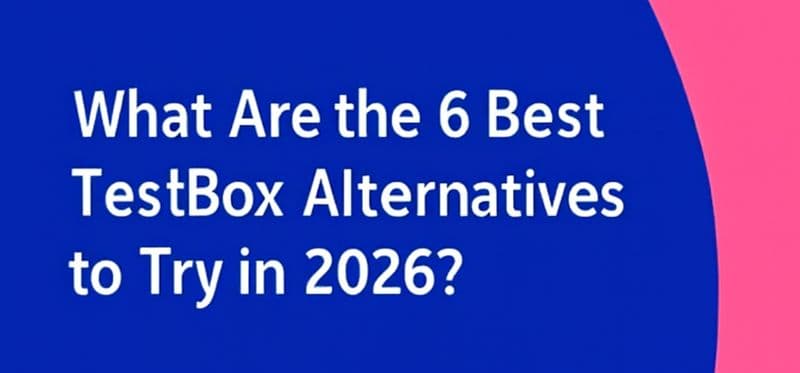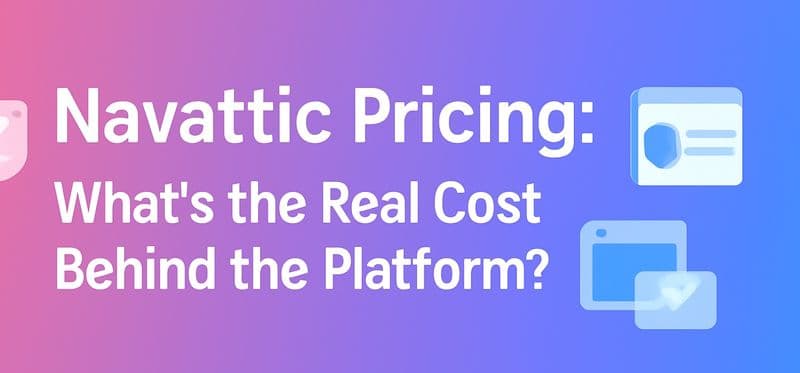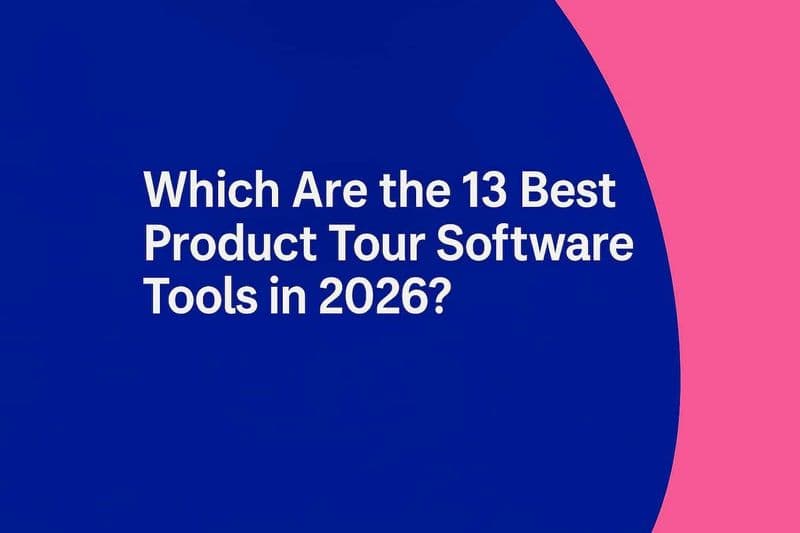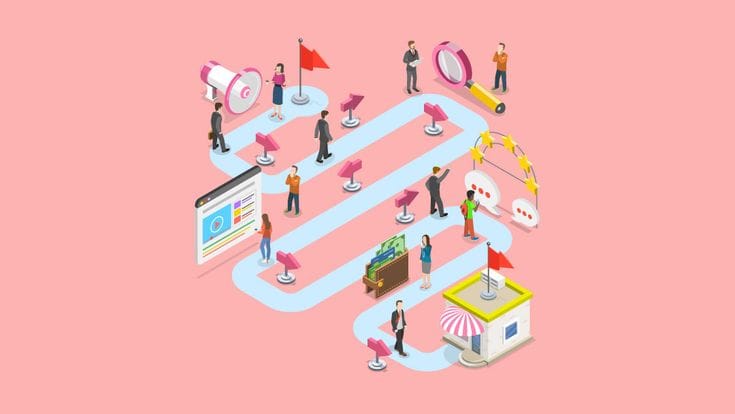
Your churn rate’s creeping up. Users are signing up… and ghosting. Support tickets are piling up with the same questions over and over. Sound familiar? That’s not just bad luck—it’s a sign you don’t really know what your customers are going through.
Enter: SaaS Customer Journey Mapping. It’s like switching from guesswork to GPS. Instead of crossing your fingers and hoping users “figure it out,” you’ll actually see the path they take—from first click to (hopefully) forever fan.
In this guide, we’ll break down how to map that journey mapping process step by step, spot where things go sideways, and create experiences that keep people coming back. Whether you’re new to the game or just tired of flying blind, this is your blueprint for building something people want to stick with.
What Is SaaS Customer Journey, And Why Is It Important?
Think of the SaaS customer journey as your user's adventure—starting from “Hey, what’s this?” to “I can’t live without it!” From discovery on social media to full-blown product evangelism, it’s a series of moments that shape how they see (and stick with) your product, including effective content marketing strategies.
Mapping this journey isn’t just a nice-to-have—it’s your cheat code to understanding what delights users, what drives them nuts, and where you might be losing them. It’s packed with insights to help you refine your product, sharpen your marketing, and keep customers coming back for more.
Bottom line? A well-mapped journey = happier users, lower churn, and way more growth.
How SaaS Customer Journey Mapping Differ from Traditional Models?
SaaS customer journeys hit differently. Unlike traditional models that juggle scattered touchpoints across stores, phone calls, and who-knows-what, SaaS journeys play out almost entirely within your platform—which means more data, more control, and more opportunities to align with your business goals to wow your users.
Here’s what sets SaaS journey maps apart:
All digital, all the time – Most interactions happen inside your product, giving you rich, trackable data.
Predictable flow – From sign-up to subscription renewals, SaaS journeys tend to follow a clear path.
Focus on adoption – Success isn’t just a sale—it’s users loving (and using) your product regularly.
Self-service heavy – Trials, onboarding, and upgrades often happen without talking to a human.
Engagement is everything – You’re not just mapping clicks—you’re tracking habits, pain points, and growth potential. Customer feedback is key.
In short, SaaS journey mapping is like a deep dive into how people really use your product—so you can make their experience better at every step.
What Are The Stages of the SaaS Customer Journey?
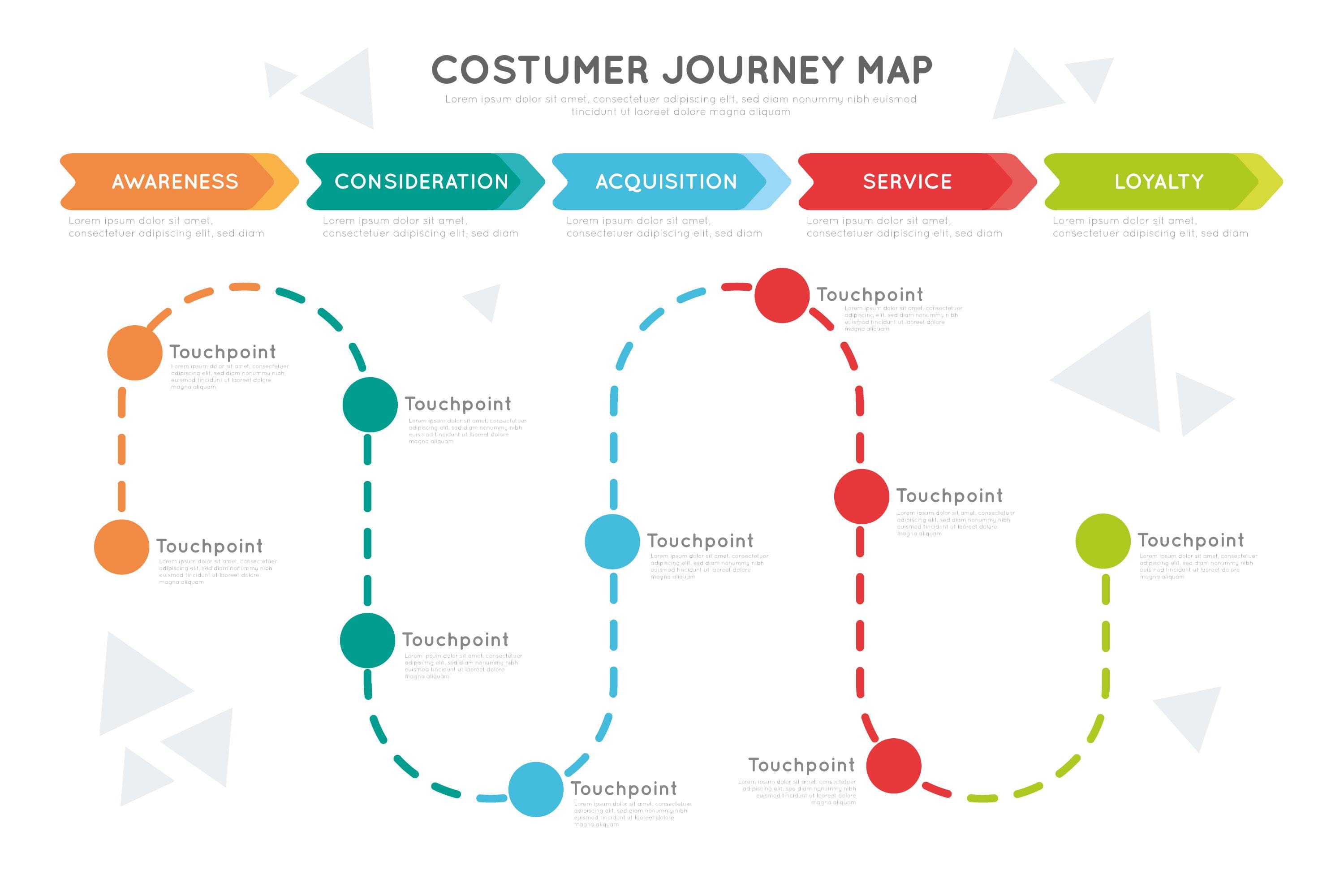
The SaaS Customer Journey includes distinct stages: Awareness (discovery), Consideration, Acquisition, Adoption (first use), Renewal, Expansion, and Advocacy (brand ambassadors). Understanding these stages is key to creating effective Customer Journey Maps.
1. Awareness
The Awareness stage is all about getting on your potential customers’ radar through strategic marketing campaigns. They don’t know you yet—but they’re about to. This is your chance to make a memorable first impression and plant the seed of curiosity about what your product can do for them.
Key elements of the Awareness stage:
Discovery channels – Ads, referral programs, social media, SEO, and word of mouth.
Educational content – Blog posts, ebooks, videos, and case studies that highlight your value.
Messaging that clicks – Clear, relatable, and problem-solving language that speaks to their pain points.
Brand voice + vibe – Set the tone for what customers can expect in terms of personality and product.
Expectation setting – Be honest and upfront about what your product does (and doesn’t) do.
At this point, it's all about attraction—grabbing attention and giving people a reason to learn more.
2. Consideration
Now that you’ve caught their eye, it’s time to win their trust. In the Consideration stage, potential customers are actively weighing their options—and your product is on the shortlist. They’re doing their homework, and your job is to make their decision easy (and in your favor).
Key elements of the Consideration stage:
Product comparisons – Highlight how your solution stacks up against competitors.
In-depth resources – Case studies, feature breakdowns, demos, webinars, and detailed FAQs.
Pricing clarity – Transparent plans, value-focused pricing tiers, and what’s included at each level.
Sales touchpoints – Product demos, consultations, and Q&A sessions that build trust and personalize the experience.
Social proof – Customer feedback, testimonials, and third-party endorsements that validate your claims.
This is where education meets persuasion. Give prospects the answers they’re looking for, and show them exactly why you’re the right fit.
3. Acquisition
The customer acquisition stage is where potential customers take the plunge—signing up for that free trial or freemium version and stepping into the world of your product. Creating a seamless onboarding process is essential to ensure it's the moment they go from curious to active, and your goal is to make that transition as smooth and enticing as possible.
Key elements of the Acquisition stage:
Easy sign-up process – A simple, quick registration that reduces friction and encourages action.
Flexible trial options – Offer enticing trial periods that let users experience your product without hesitation.
Seamless onboarding – Make the first interactions intuitive and engaging, so users feel confident from the get-go.
Clear value delivery – Quickly showcase how your product solves their problem and why they should stick around.
Prompt follow-ups – Send automated welcome emails, tips, or reminders to keep users engaged.
This stage is about setting the stage for long-term success—making sure users see the value right away and feel excited to keep using your product.
4. Adoption
Now that users are onboarded and comfortable, the Adoption stage begins. This is where they start to dive deeper into your product, discovering its advanced features, figuring out how it fits into their routine and whether it truly solves their problems. It's about helping them realize the value and making sure they stick around.
Key elements of the Adoption stage:
Ongoing education – Provide resources like blog posts, whitepapers, webinars, and instructional videos to guide users through key features.
Support for success – Ensure customer support is readily available to help with any questions or challenges.
Feature exploration – Encourage users to discover and master your product’s core features, leading to those “aha!” moments.
Customer engagement – Regular check-ins, tips, and updates to keep users engaged and invested.
Personalized experiences – Tailor the product experience to meet the specific needs of users, increasing satisfaction and retention.
This is where the magic happens. When users see real value and start using your product regularly, you’ve got them on the path to long-term success.
5. Renewal
Renewal is a pivotal moment for any SaaS product. It’s the first real purchase, typically after a free trial, and it shows whether the user truly finds value in what you offer. This stage is key in transitioning users from free to paying customers, and it can make or break long-term retention.
Key elements of the Renewal stage:
Value realization – Ensure users have experienced enough value during the trial to feel confident about renewing.
Seamless transition – Make the switch from free to paid easy, with minimal friction and clear instructions.
Regular communication – Keep in touch with users, addressing any concerns and reinforcing the benefits of continuing their subscription.
Personalized reminders – Send tailored messages highlighting the product’s value and any new features they’ve missed.
Clear pricing options – Ensure users understand the pricing tiers and what they get at each level.
A smooth, value-driven renewal experience keeps users engaged and ensures they stay for the long haul.
6. Expansion
Expansion is all about taking your existing customer relationships to the next level. This stage focuses on upselling and offering feature upgrades that align with users' evolving needs, helping you stretch revenue while providing more value.
Key elements of the Expansion stage:
Upselling opportunities – Offer users additional features or premium plans that enhance their experience.
Tailored recommendations – Align upsell offers with the user’s needs and journey, showing how the upgrade solves their challenges.
Clear value proposition – Make sure customers see the benefits of upgrading and how it fits into their goals.
Flexible packages – Provide multiple options, so users can easily find the right fit for their growing needs.
Customer success support – Continuously engage with users to ensure they're getting the most out of their current plan and identify potential expansion opportunities.
When done right, expansion helps deepen customer loyalty while driving growth—everyone wins.
7. Advocacy
The Advocacy stage is where you turn satisfied users into passionate promoters. These advocates are more than just regular customers—they actively spread the word about your product and share their experiences with others.
Key elements of the Advocacy stage:
Referral programs – Encourage users to refer others in exchange for rewards, turning them into brand ambassadors.
Requesting reviews – Ask happy customers to leave testimonials or reviews that boost your credibility.
User-generated content – Let advocates create content like blog posts, case studies, or social media mentions to amplify your reach.
Community building – Foster a community where users can share tips, ask questions, and help each other succeed.
Social proof – Leverage the power of word-of-mouth and testimonials to build trust with new prospects.
When your customers become advocates, you’re not just gaining more users—you’re getting powerful endorsements that attract even more loyal fans.
How to Map Your SaaS Customer Journey?
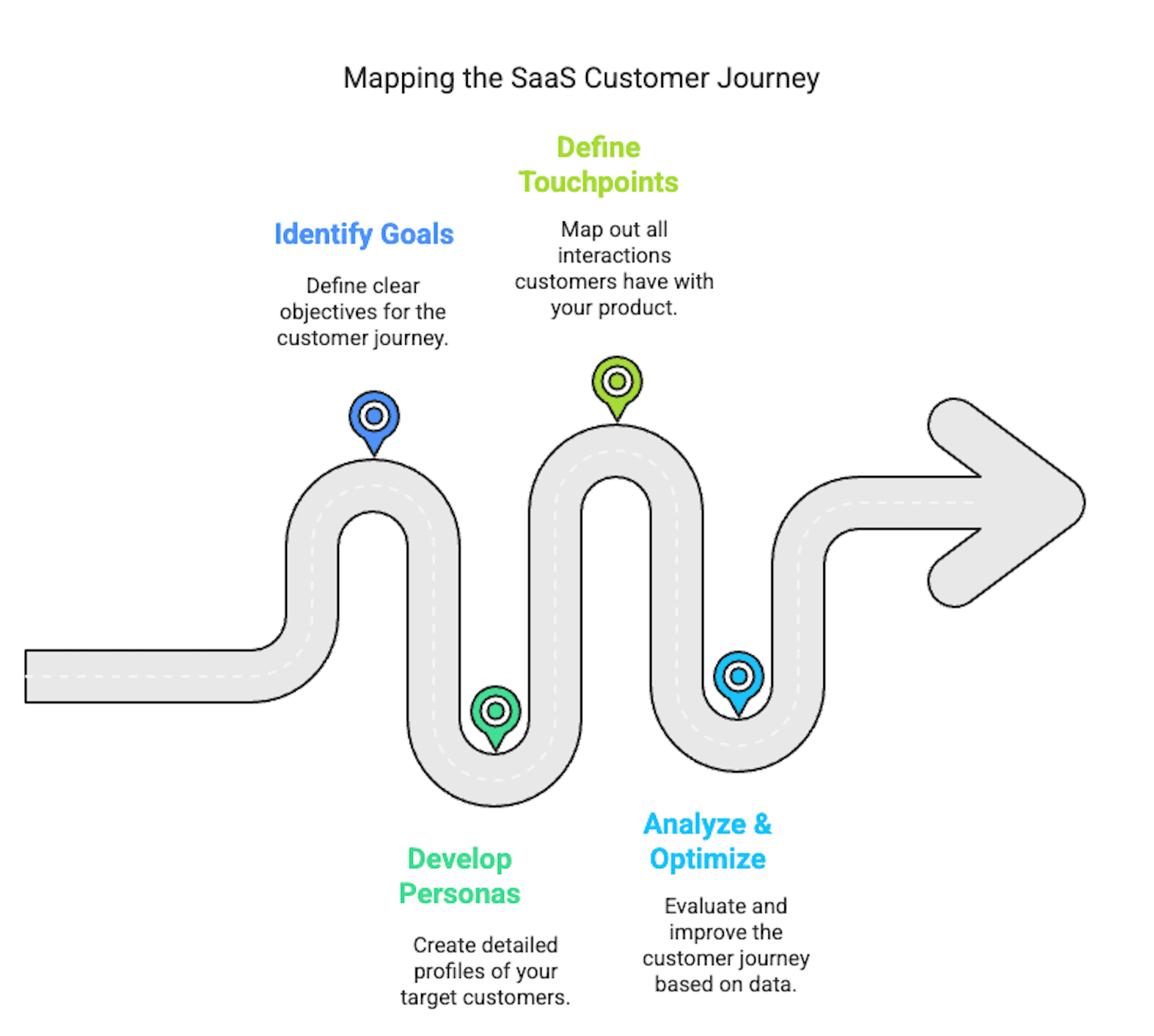
Mapping your SaaS Customer Journey requires understanding your goals, defining user personas, identifying touchpoints, spotting gaps, and refining the map continuously. Each stage should be analyzed in detail, with regular testing and updates. Let’s dive into how to map your SaaS Customer Journey effectively.
1. Identify Your Goals and Objectives
Before diving into mapping, it’s crucial to define clear goals that align with your business objectives. These goals help you stay focused and target the right areas for improvement.
Key objectives to consider:
Lead generation – Increase the number of qualified leads.
Boost conversion rates – Turn more prospects into paying customers.
Reduce customer complaints – Address pain points to improve satisfaction.
Revamp brand messaging – Refresh your product’s image and messaging.
Launch new features – Ensure smooth adoption of new product updates.
Clear goals provide direction and ensure your map delivers the results you want.
2. Develop User Personas
User personas are fictional representations of your ideal customers, which aid in aligning your product and marketing strategies with their specific needs, behaviors, and objectives. Creating accurate user personas is crucial in understanding who your actual users are and how different user groups may interact with your product.
Here are some key aspects to keep in mind while developing user personas:
Gather Data: Conduct surveys and interviews to get a deeper understanding of individual customer needs and goals.
Identify Patterns: From the collected data, identify common patterns and group them together to form different personas.
Develop Profiles: Create detailed profiles mentioning demographics, job roles, behaviors, preferences, and expectations.
Validate and Refine: Over time, continue to validate the personas' accuracy and refine them as necessary based on new data and feedback.
Remember, personas are not static. They should evolve as your business, offerings, and market dynamics change.
3. Define Customer Touchpoints
Every interaction a customer has with your business, from browsing your website to chatting with a sales rep, is a touchpoint that can highlight important customer milestones. Understanding these moments helps you shape your customer’s experience and pinpoint areas for improvement.
Common SaaS-related touchpoints:
Website Visits – Customers explore your site to learn about your product or seek support.
Free Trials – Prospects experience a limited version of your product to see if it meets their needs.
Customer Support – Handling customer inquiries, complaints, or issues through support channels.
Social Media Posts – Engagements and interactions with your brand on social platforms.
Tracking and refining these touchpoints ensures a smoother, more enjoyable experience for your customers.
4. Analyze and Optimize the Journey
Analyzing your mapped customer journey means evaluating touchpoints to see if they’re effectively guiding users through the stages of your marketing efforts. Look for gaps, friction points, or any areas that may be disrupting the flow.
Key steps to follow:
Identify touchpoint effectiveness – See if each touchpoint is pushing customers forward or causing friction.
Check for gaps and anomalies – Look for where customers might get stuck or drop off.
Review customer feedback – Gather insights from reviews and surveys to better understand pain points.
Optimize and refine – Continuously improve based on findings to enhance the experience.
This isn’t a one-time task—it’s an ongoing process of fine-tuning your customer journey for maximum engagement and value.
What Are The Benefits of Effective Customer Journey Mapping in SaaS?
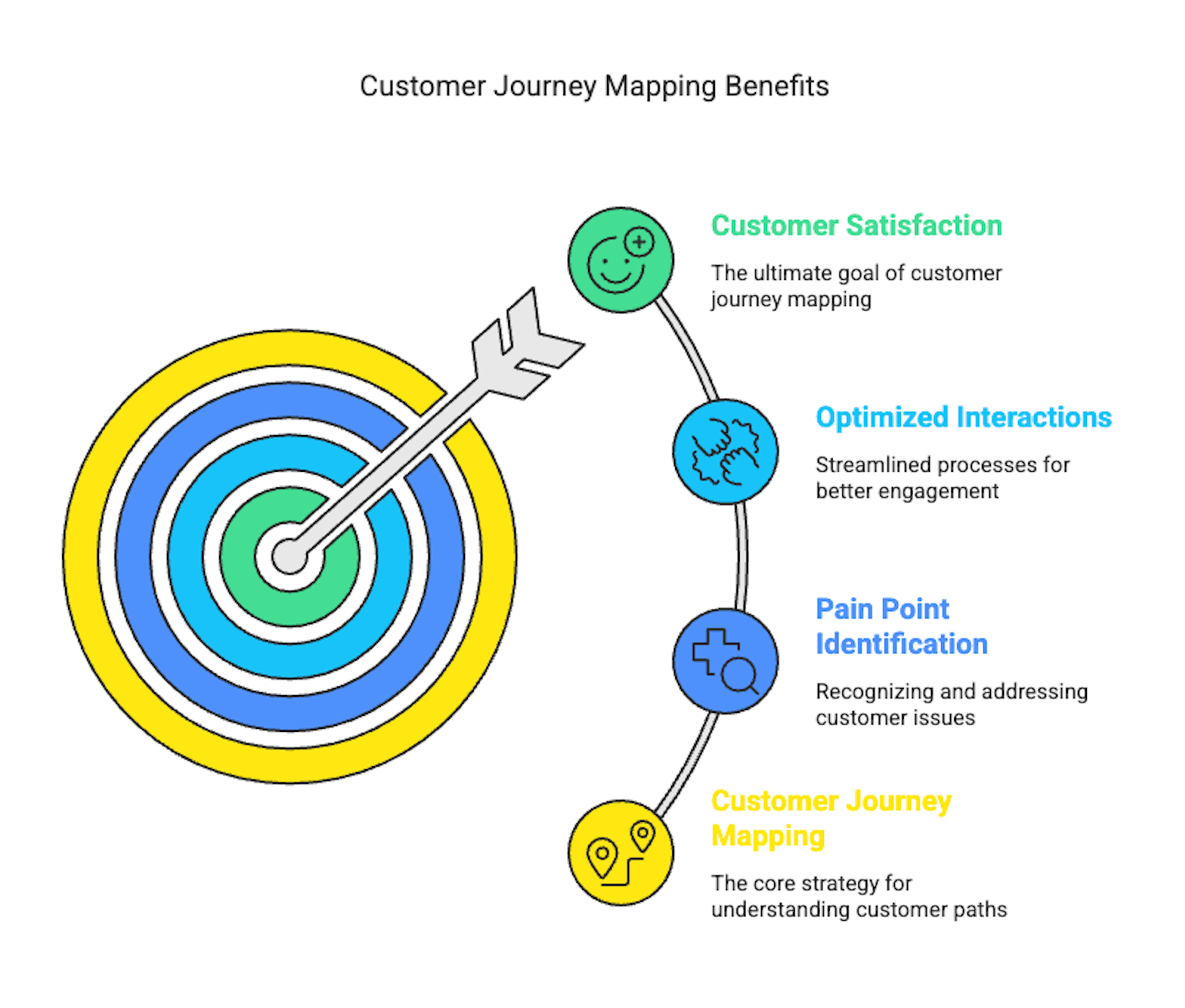
Customer Journey Mapping in SaaS isn’t just a tool—it’s a game-changer for growth and success. By refining your customer journey, you can improve the user experience, boost retention, and increase lifetime value. Let’s explore the benefits of b2b saas customer journey map in detail.
1. Enhanced Customer Experience
A mapped journey helps you see your product through the customer’s eyes, fine-tuning each touchpoint for a smoother, more engaging experience. Identifying and fixing roadblocks promotes customer loyalty by reducing friction and enhancing satisfaction.
2. Increased Customer Retention
Mapping reveals pain points where users may disengage, giving you the chance to address them strategically. By improving the experience at each stage, you’ll keep customers happy and loyal, reducing churn and fostering long-term relationships.
3. Higher Customer Lifetime Value
An optimized customer journey ensures ongoing value delivery, encouraging users to stick with your product longer and potentially upsell. Happy customers are more likely to renew, spend more, and even refer others, boosting your overall revenue.
By consistently refining the customer journey, you turn satisfied users into loyal advocates and long-term revenue drivers..
What Are The Metrics to Measure the Success of SaaS Customer Journeys?
To ensure your customer journey map is effective, it must be measurable. By setting benchmarks and tracking key performance indicators (KPIs), you can evaluate if your map is delivering the desired results. Here are essential metrics to measure the success of a SaaS customer journey.
Key Performance Indicators (KPIs) to Monitor
It’s crucial to set trackable KPIs that map progress against your customer journey mapping goals. Here are a few common KPIs you must monitor to assess your journey map's success:
KPI | Description |
|---|---|
Customer churn rate | Measures the percentage of customers who stop subscribing to your service. |
Net promoter score (NPS) | Assess customer loyalty and their likelihood to recommend your product. |
Conversion rates | Tracks the number of people converting at each stage of the funnel. |
Time spent onboarding | Determines the duration taken for a user to fully adopt your service. |
Each metric gives insights into how well your customer journey map is fulfilling its objectives and where there might be scope for improvement.
What Are The 2 Challenges in SaaS Customer Journey Mapping?
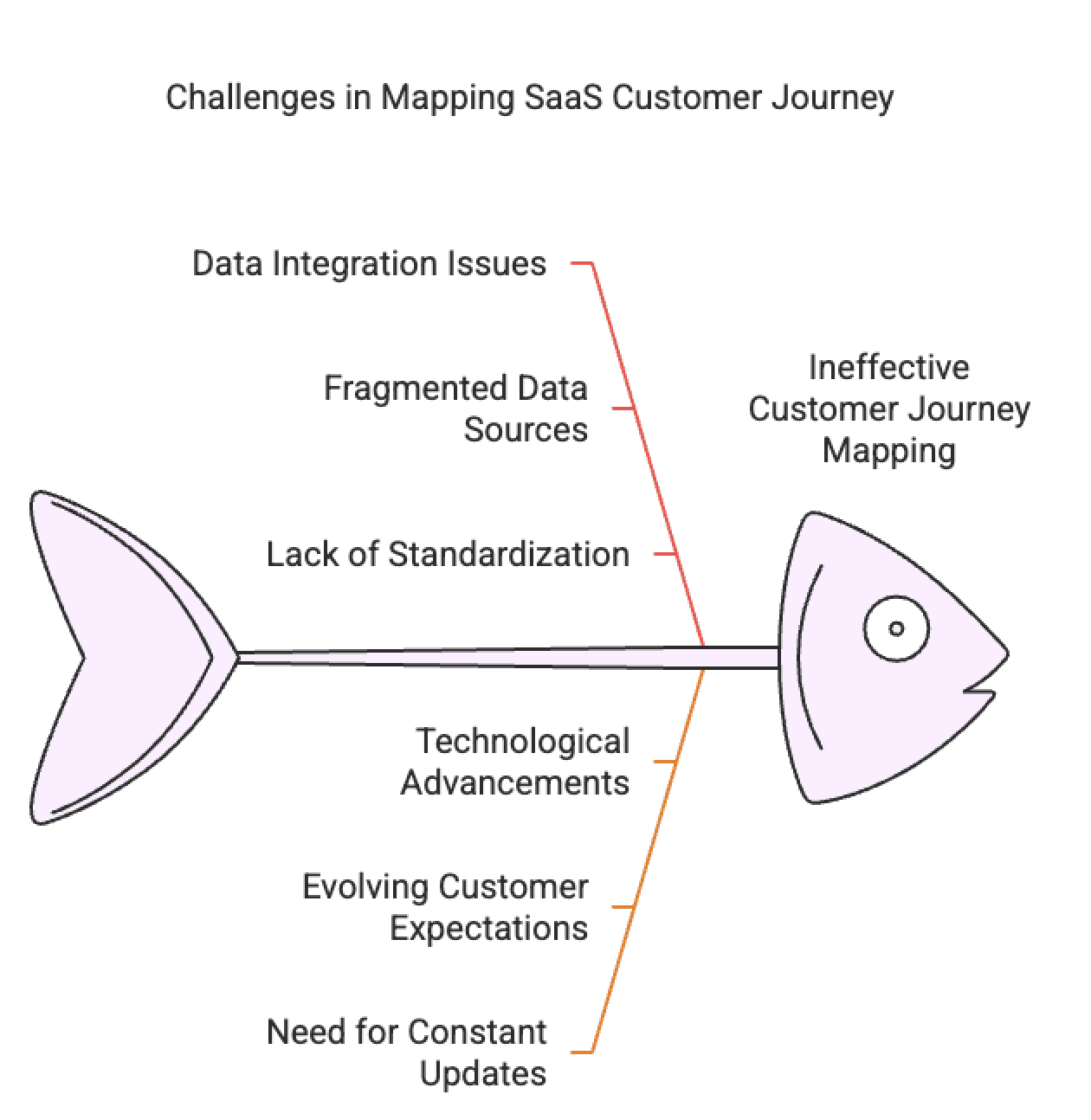
Implementing a successful SaaS Customer Journey isn't a walk in the park. It comes with its share of challenges, such as integrating data from multiple sources and the perpetual need to keep updating and optimizing your map. to align with the customer’s needs. Understanding these obstacles not only equips you to navigate them better but also reinforces the importance of frequent optimization and testing.
Data Integration Issues
With the explosion of digital interactions, SaaS companies generate massive amounts of customer data across multiple platforms at each stage of the journey. The challenge lies in integrating this data into a single, cohesive view of the customer experience, especially when trying to merge offline and online data sources.
Solution: Implement Robust Data Management and Analytics Systems
To tackle data integration challenges, companies should invest in:
Effective data management strategies – Establish clear processes for collecting, storing, and organizing data.
Advanced analytics platforms – Use tools that can handle large data volumes and provide accurate insights from diverse sources.
Automation and integration – Leverage software that can automatically merge online and offline data into a unified view.
Data visualization tools – Make data more digestible by using dashboards that present insights in an easy-to-understand format.
Constant Need for Updating and Optimization
The ever-changing nature of the SaaS industry means customer behaviors and preferences are constantly shifting. A customer journey map, particularly the current state map, that works well today might become outdated tomorrow due to new trends or technological changes.
Solution: Continuously Update and Optimize the Journey
To stay ahead, SaaS companies should:
Regularly review the map – Ensure it reflects current customer needs and industry trends.
Leverage real-time data – Use analytics and feedback to stay on top of evolving user behaviors.
Embrace new technologies – Adapt your journey map to include advancements in tools and features.
Test and iterate – Continuously optimize the journey by testing new strategies and learning from results.
Improve Your SaaS Conversions with SmartCue
SmartCue empowers SaaS businesses to transform their sales approach by delivering personalized, interactive product demos that captivate prospects and drive higher conversion rates.
Why Choose SmartCue?
Quick Demo Creation: Craft tailored demos in just 6 minutes, enhancing lead engagement and qualification.
Seamless Integration: Easily embed demos on your website or share them via links, aligning with your sales and marketing workflows.
Comprehensive Analytics: Monitor metrics like engagement rates, time spent, and conversion rates to refine your strategies.
Device Compatibility: Ensure a consistent experience across desktops, tablets, and mobile devices.
Experience the impact of SmartCue firsthand. Start your 14-day free trial today.
Conclusion
A well-executed SaaS customer journey map can transform your business by providing insights into customer needs, pain points, and interactions. It helps enhance user engagement, improve the user experience, reduce churn, boost retention, and increase profitability.
However, creating a successful map comes with challenges, like regular updates, data integration, and adapting to shifting customer expectations. With the insights from this guide, you’ll be equipped to create and optimize a journey map that aligns with your customers’ needs and drives your business forward.
Frequently Asked Questions
What are the common mistakes in creating a SaaS customer journey map?
Common mistakes often involve inadequate customer research leading to incorrect assumptions, overlooking essential touchpoints, not updating the map regularly based on changing customer behavior, or failing to tie the journey map to specific, measurable objectives.
How often should you update your SaaS customer journey map?
As a best practice, it's advisable to review and update your SaaS customer journey map every six months or whenever there's a significant change in your product or market conditions.
Can customer journey mapping be automated?
While software tools can gather data and illustrate customer journeys, the interpreting, optimizing, and strategic planning necessitate human intervention. Therefore, while automation can aid in the process, complete automation of customer journey mapping isn't feasible.
